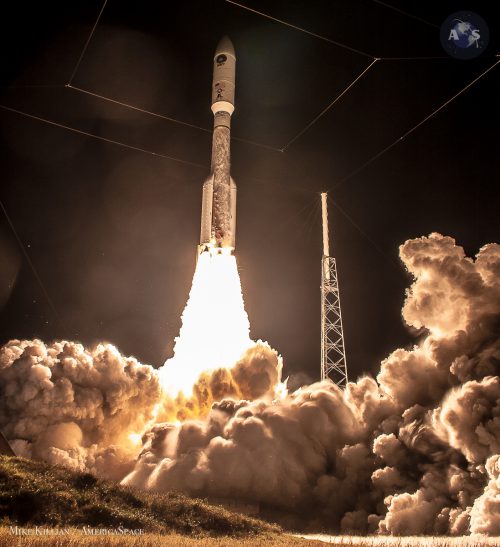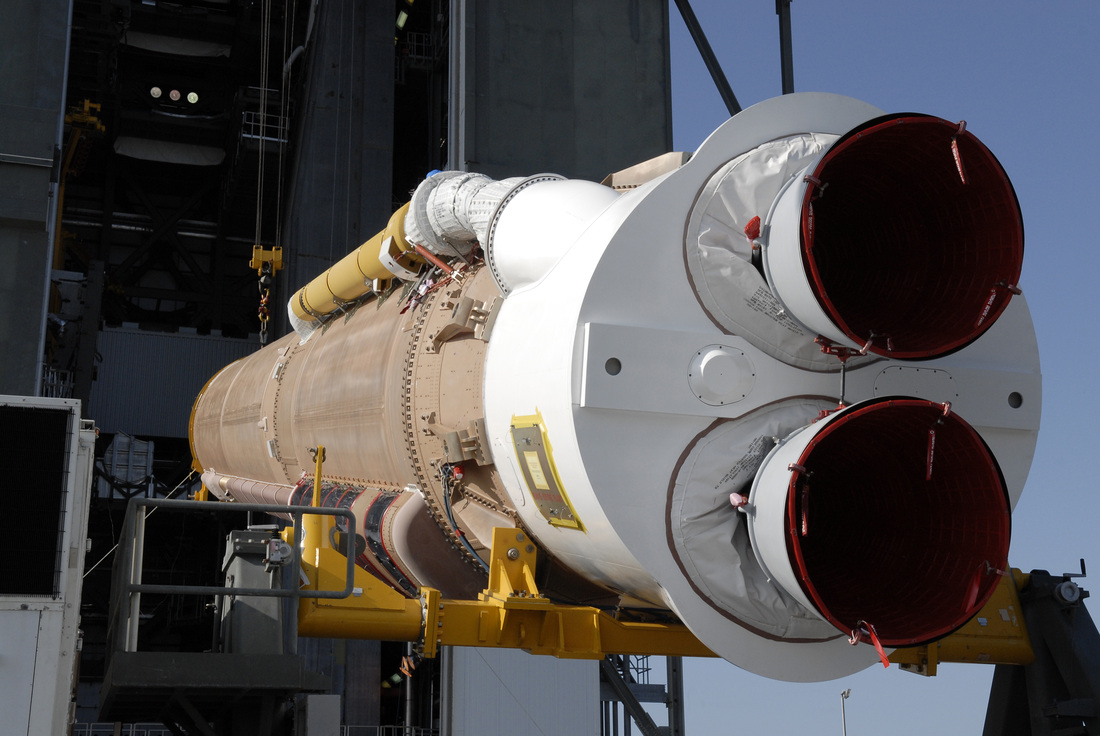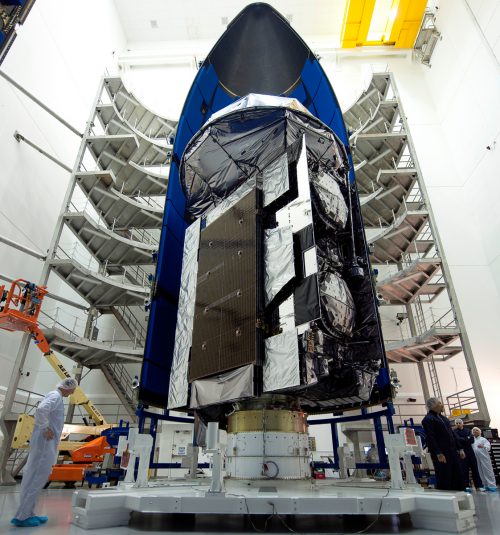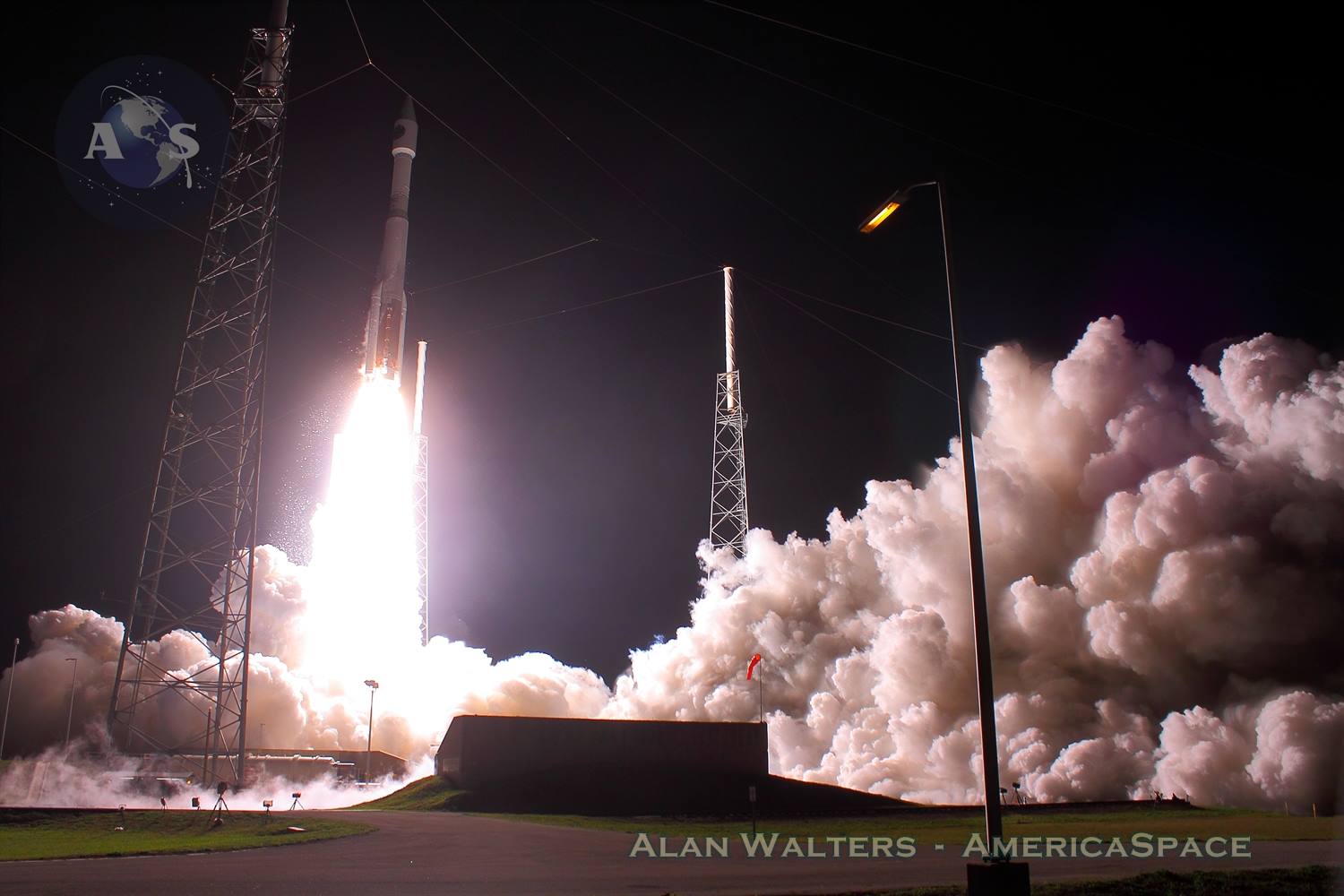-
Being grounded for the last several months due to an investigation into an engine anomaly on the OA-6 launch, ULA’s workhorse Atlas-V booster is ready to return to flight later this month, tasked with delivering a 7.5-ton NAVY satellite to geosynchronous transfer orbit. Requiring the full potential of the Atlas-V, with five strap-on motors, MUOS-5 will roar to space from Launch Complex-41 at Cape Canaveral AFS as soon as next Friday, following a Senate deal this week on the future of the booster’s controversial RD-180 engine.
Liftoff is scheduled for 10:30 a.m. EDT June 24; the launch window extends to 11:14 a.m EDT.
Congress has grown increasingly alarmed that Russian President Vladimir Putin could halt deliveries of the RD-180 before the U.S. can field a replacement, which isn’t expected to be operational and certified until 2021/2022. The engine powers many of the country’s most sensitive national security assets into space, as well as critical communications and science satellites and spacecraft.

A ULA Atlas-V 551 rocket launching the NAVY’s MUOS-3 satellite. Photo Credit: Mike Killian / AmericaSpace MUOS-5 itself is a national security-related mission. It’s the fifth satellite in a Lockheed Martin-built five-ship fleet for a next-generation, narrowband tactical military communications system for the NAVY, called the Mobile User Objective System.
MUOS-5 will serve as an on-orbit spare, should it ever be needed.
On Tuesday, a defense bill passed the Senate which allows ULA to buy up to 18 RD-180 engines until the year 2022.
On Dec. 16, 2015, a $1.1-trillion, 2000-page 2016 Omnibus Spending Bill, agreed to by the House and Senate, allowed ULA to procure more RD-180s. In a previous AmericaSpace report by Craig Covault, the budget action set off one of the most bitter congressional fights in decades involving the U.S. space program and foreign policy.
At the time, Sen. Richard Shelby (R-Ala.), who led opposition to the ban, said that to continue it would be “reckless” and endanger U.S. assured access to space for national security payloads, most of which are launched on the Atlas-V. Defense Secretary Ashton Carter agreed with the action.
The move, however, drew thunderous opposition on the floor of the Senate from Sen. John McCain (R-Ariz,), who opposed lifting the ban because of outrage over rewarding Russia after its invasion of Ukraine and its bombing of U.S. allies in Syria.
In the Senate deal this week, McCain, who is chairman of the Senate Armed Services Committee, agreed to ULA having access to 18 engines, saying he agreed to the compromise because of the 2022 cutoff on RD-180 dependence. The deal also puts pressure on the Pentagon to develop a new rocket for national security payloads, on American-made engines, by 2022.
“For the first time, Senate authorizers and appropriators agreed to a legislative cutoff date for the use of Russian rocket engines in national security space launches,” said McCain. “As a result, no space launch contracts using Russian rocket engines may be awarded after 2022, and the number of Russian engines utilized could actually be lower than the 18 provided in the House bill.”
The U.S. Air Force is currently funding development of both the Aerojet Rocketdyne AR1 and the Blue Origin BE-4 engines to end dependence on the RD-180 for the Atlas-V and ULA’s future Vulcan rocket.
As noted in a March 2016 report by Covault, the total AR1 agreement is valued at $804 million, with the Air Force investing two-thirds of the funding required to complete development of the AR1 engine by 2019. The Air Force intends to initially obligate $115.3 million with Aerojet Rocketdyne and ULA contributing $57.7 million.
In a separate action the Air Force also awarded ULA a $46.6 million contract to develop prototypes of its liquid oxygen/liquid natural gas (LNG) Blue Origin BE-4 booster engine and its BE-3 liquid oxygen/liquid hydrogen Advanced Cryogenic Evolved (ACES) upper-stage engine.

Each Atlas V is powered by a single oxygen/kerosene Russian RD-180 with two engine nozzles. By 2019 ULA hopes to instead power the launcher with two BE-4 methane/oxygen engines. Photo Credit: NASA / ULA SpaceX was certified by the Air Force last year to compete for sensitive national security space launch contracts against ULA, and last April the company was awarded their first military launch with the GPS III satellite.
The Air Force also awarded Orbital ATK a $47 million contract earlier this year for development of a “solid rocket propulsion system prototype” to support national security space missions. The award includes options for additional scope, valued at up to $133 million.
Orbital ATK has been in negotiations with NASA’s Kennedy Space Center for a “prospective property use agreement” ever since, looking at High Bay 2 in the iconic Vehicle Assembly Building (VAB) to support the new booster.
“This funding, together with our own research and development investments, will lead to an operational launch capability in 2019,” said Scott Lehr, President of Orbital ATK’s Flight System Group.
———————————————————————————————
Atlas-V Ready to Return to Flight
———————————————————————————————While the battle over the future of the RD-180 for U.S. space launch finally appears to be over, ULA is looking forward to a busy manifest through the end of the year, having launched the classified NROL-37 eavesdropping satellite atop a Delta-IV Heavy just days ago.
The last Atlas-V launch on March 22 delivered Orbital ATK’s OA-6 Cygnus freighter to the ISS for NASA successfully, but not without incident. The rocket’s first stage experienced an “anomalous propellant mixture ratio” during its burn, which resulted in the RD-180 shutting down pre-maturely.

MUOS-5 being encapsulated in its launch fairings. Photo Credit: ULA According to ULA: “The Atlas V’s robust system design, flight software, vehicle margins and propellant reserves enabled the successful outcome for this mission. The Centaur upper stage identified the first stage performance shortfall and compensated with an extended burn to deliver Cygnus to the precise orbit, well within the required accuracy.”
A review team made up of ULA engineers, the engine supplier, and several government customers determined the following, from ULA:
“At approximately T+222 seconds, an unexpected shift in fuel pressure differential across the RD-180 Mixture Ratio Control Valve (MRCV) and a reduction in fuel flow to the combustion chamber caused an oxidizer-rich mixture of propellants and a reduction in first stage performance. The imbalanced propellant consumption rate resulted in depletion of the first stage oxidizer with significant fuel remaining at booster engine shutdown. The engine supplier has implemented a minor change to the MRCV assembly to ensure the anomaly does not occur on future flights.”
“Engine hot-fire testing, extensive component and assembly level testing and analyses have been performed to confirm the findings. Detailed inspections and minor hardware replacement on all engines will support the current launch manifest,” added ULA.
“’We remain on plan to launch all of our manifested 2016 missions within the year,” said Laura Maginnis, ULA’s vice president of Custom Services.
The NAVY’s 15,000-pound MUOS-5 was encapsulated inside the Atlas-V’s bullet-like protective cone for launch on June 4.
MUOS operates like a “smart phone cell tower in the sky,” supporting a worldwide, multi-service population of users in the UHF band, providing increased communications capabilities to smaller terminals while still supporting interoperability with legacy terminals. The new military SATCOM system will, for the first time, give MUOS Wideband Code Division Multiple Access technology users beyond-line-of-sight capability to transmit and receive voice and data using an Internet Protocol-based system, giving users greater mobility, higher data rates, and improved operational availability.
“Mobile forces, equipped with MUOS terminals, will soon be able to communicate with each other – including voice, data and exchanging imagery – real-time, virtually anywhere on the Earth,” said Iris Bombelyn, Lockheed Martin’s vice president for Narrowband Communications. “This is a tremendous upgrade in communications capabilities over what currently exists for our nation and our allies.”
Report by Mike Killian and Craig Covault.
.
Be sure to “Like” AmericaSpace on Facebook and follow us on Twitter: @AmericaSpace.
Missions » MUOS » Missions » MUOS » MUOS-5 »
Atlas-V Returns with MUOS-5 June 24, Senate Says No More Russian Engines by 2022
SpaceX Successfully Delivers Eutelsat/ABS Satellite Duo to Orbit





